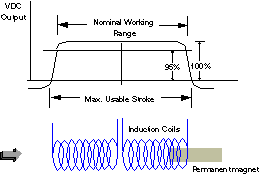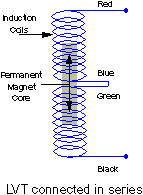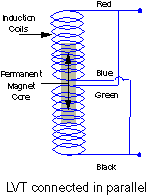Resources
Linear Velocity Transducer (LVT) Technology
Trans-Tek manufactures and designs Linear Velocity Transducers using inductive technology. Moving a magnet through a coil of wire will induce a voltage in the coil according to Faraday’s and Lenz’ Laws. This voltage is proportional to the magnet’s velocity and field strength. TRANS-TEK LVTs use this principle of magnetic induction, with a permanent magnet and a fixed geometry coil, so the output voltage of the coil is directly proportional to the magnet’s relative velocity over its working range.

During operation in the working range of the transducer, both ends of the magnet are inside the coil. With a single coil this would give zero output because the voltage generated by one pole of the magnet would cancel the voltage generated by the other pole. To avoid this, the coil is divided into two sections, so the N (North) pole of the magnet will induce a voltage in one coil and the S (South) pole will induce a voltage in the other coil. These two coils are then connected in series-aiding, to obtain a DC voltage output proportional to the magnet’s velocity.
Coils in Series
For series operation, the blue and green leads are tied together and the output is taken from the black and red leads. With the coils wired in series, the output is summed, producing the maximum sensitivity. Besides a high sensitivity, the transducer exhibits excellent noise immunity, attributed to the coils being wound in series opposition. Noise generated on one coil will be equal in magnitude but opposite in polarity to the other coil.
Coils in Parallel
Parallel operation is achieved by tying the black and blue leads together, and the green and red leads together. The two connections create the terminals for the output. This configuration cuts the sensitivity in half, and reduces the source impedance by a factor of 4. The benefits of this arrangement are: lower output, for use in high speed applications; lower output impedance, for compatibility with electronics with a low input impedance, and higher frequency response for a given load impedance.
Magnets
The LVT’s performance is directly associated with the condition of the magnet, or magnet assembly. In order to maintain optimum performance it is necessary to preserve the integrity of magnet used with the transducer.
Trans-Tek uses two different magnetic materials in the LVT’s:
ALNICO and CUNIFE.
ALNICO is made from sintered metal, and is characterized by its high sensitivity, brittleness, plated surface, and threaded brass endcaps.
CUNIFE is machined from bar stock, and is characterized by its lower sensitivity rating than ALNICO, ruggedness, visible draw marks, and threads directly in magnet.
Proper Care of Magnets
Subjecting the material to a very strong electromagnetic field of predetermined polarity aligns the molecule’s charges. The strength of the magnetic field is a function of the strength of each molecule’s charge, the number of molecules aligned and the path that the field takes. Proper care of the magnet is primarily a matter of guarding against changes in molecular alignment and magnetic field.
Based upon our customers collective experiences, the most common causes of demagnetization are listed below:
Changing the internal field path of the magnet.
Inducing internal stresses by bending or gripping the magnet with pliers, or altering the magnetic path by scratching the magnet.
Operating in very strong electromagnetic fields.
If a strong electromagnetic field is introduced that interrupts the magnet’s field, it may disrupt the alignment of the molecules – resulting in a loss of magnetization. The duration and strength of exposure to the secondary electromagnetic field will determine how much magnetic field strength is lost
Approaching or exceeding the Curie Temperature.
The Curie Temperature of a magnet is the point at which the molecules return to their natural random polarization. For ALNICO magnets it is 540°C; for CUNIFE magnets it is 840°C. The recommended operating ranges for these magnets are 300°C and 540°C, respectively. If operating between the recommended operating range and the Curie Temperature, there will be some permanent loss of magnetic field strength which will equate to loss of sensitivity. Operation at or above the Curie Temperature will result in permanent loss of all magnetic field strength.
Contacting another strong magnet
This has the same effect as subjecting the magnet to a very strong opposing magnetic field.
Subjecting the magnet to a physical shock.
A shock force of substantial magnitude will disrupt the alignment of the molecules. The amount and permanency of the loss depend on factors such as the magnitude and direction of shock force as well as duration
Crack(s) in the magnet
Cracks in a magnet disrupt the continuity of the field and result in the loss of strength. ALNICO magnets are particularly susceptible to cracking if dropped.

